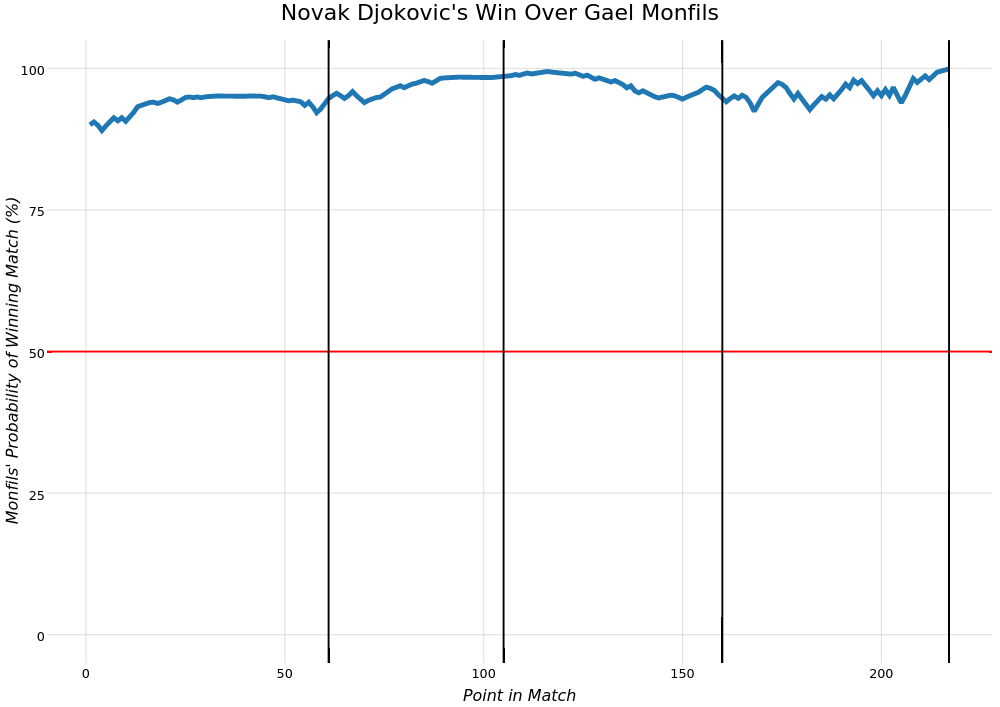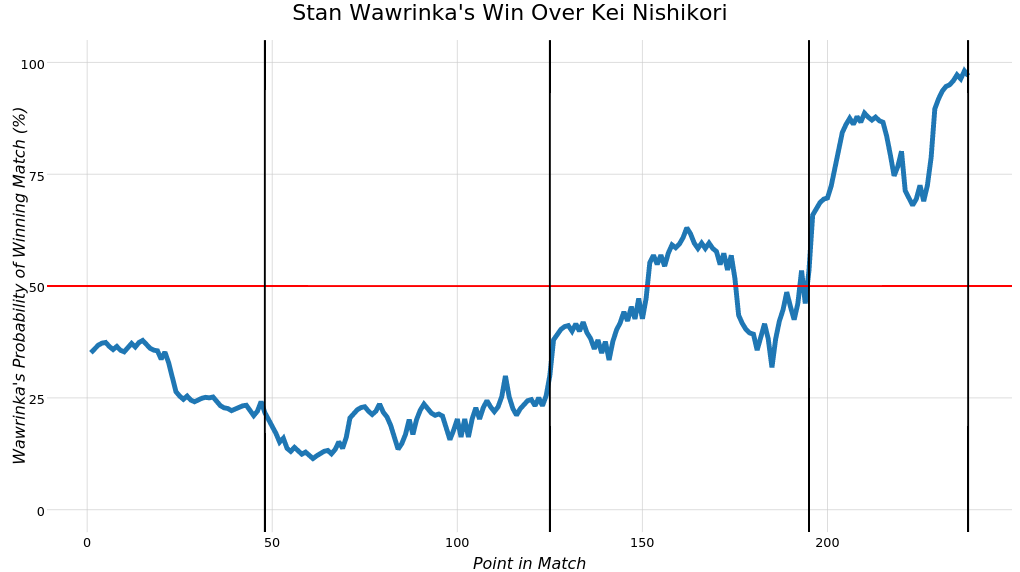Visualizations of Day 12 at the 2016 U.S. Open
10 Sep 2016After a day of women’s semifinals that saw the exit and dethroning of World No. 1 Serena Williams, the favorites in the men’s semifinals had to be on guard when they stepped onto court today. The first match of the day pitted a fresh Novak Djokovic against showman and crowd favorite Gael Monfils. The day was be closed out by the matchup of Kei Nishikori and Stan Wawrinka. Both matches were hard-fought and delivered a packed highlight reel. It will now be left to Novak Djokovic and Stan Wawrinka on Sunday in Flushing to decide who will be the next men’s U.S. Open champion. Here is how they earned a chance for the trophy.
Djokovic Lives Up to Expectations
Defending champion, Novak Djokovic, was a near certain bet to take the semifinal, according to tennis forecasts that gave him a 90% chance of beating the Frenchman. With only 84 games played going into the semifinal—the lowest number in U.S. Open history during the modern era by 28 games—that staggering forecast was probably still conservative.
But no one should discount even a 10% chance when it is Gael Monfils on the other side of the net. Monfils has a history of taking down top 10 players when it has been least expected. He has beaten Roger Federer 4 times and Rafael Nadal 2 times, though he has never beaten Djokovic. No matter the chances for a win, there is a 100% probability that he will put on a good show with his flare and gutsy shot-making.
It’s a good thing that Monfils couldn’t see Djokovic’s match win predictions as the match progressed. After quickly winning the first two breaks in the first set, his strong chances of win increased to near certain levels. That is astounding when it is only the fifth game of the match and one is playing the World No. 12 who has been having one of the best seasons of his career. But that is what it is to play like Novak Djokovic these days.
The score line might it made look like Monfils didn’t give Djokovic much of a fight in the match but he actually generated 11 break chances and had a conversion rate that was only slightly under Djokovic’s. The problem is that Djokovic created 9 chances more, creating a huge gap in total breaks.
From the match chart, we can see that the third and fourth sets were where the most change in the odds occurred. The first turning point for Monfils was the fourth game of the third set, when he earned the one break of the set back and made it an even contest for the set. When Monfils found a way to win a second break in his next return game, he was on track to take the set and drop Djokovic’s win chances from certain to near certain levels.
After being the first to lose a service game in the fourth game of the fourth set, Monfils made a huge mental effort to win that break back in the next game. But Djokovic countered and after 10 tough points took Monfils’ next service game. At that point, Monfils had little time left to turn things around and an textbook Djokovic need just two more games to take the set and match.
Stan Makes a Statement
Although Stan Wawrinka is the only player of the second men’s semifinal to have won Major titles, his up-and-down year gave Nishikori the edge in model forecasts. Predictions from FiveThirtyEight gave Wawrinka just a 35% of a chance of getting to another Grand Slam final stage this year.
In the first set, things looked on track to fulfill those predictions. Nishikori got the first break in the fifth game, which turned out to be the only break chance and conversion in the set. After losing the first set, Wawrinka’s chances were down to 20%. Things took a worse turn quickly in the second when Wawrinka was broken in the first game. At that point, Wawrinka’s chances of coming back had dipped to an unlucky 13%.
Fans might have been wondering at this stage in the match if Wawrinka was using the same strategy that Monfils apparently executed unsuccessfully in his semifinal: surprise your opponent with a poor performance in the first set. Whatever the cause, seemed to come to life in Wawrinka fourth game of the second set when he got his first break point of the match and converted. Wawrinka went on to escape from two heated service games in which he fought off six break points. Wawrinka beat Nishikori to the break and took the second set, returning his odds back to their pre-match level.
It was all Wawrinka in the first five games of the third set. Then, Nishikori looked like he was vying to turn things around when he saved two break point threats in the sixth game and won the break in the seventh. But it was Wawrinka who would take the break when it was needed most in the tenth game, a pattern that happened more than once throughout the match.
With two sets on the board and a one set lead, Wawrinka had won the odds to his favor. By the first point of the fourth set, Wawrinka’s win chances were at 70%. A break of Nishikori’s service in the second game brought those chances to a decisive 88%. But Nishikori wasn’t going away too easily, not after fighting so hard against Andy Murray to get to this point. Nishiokri made his big move in the fifth game, creating 3 break chances and eventually converted the third. Wawrinka immediately responded, however, and made some stunning shots to get the break back in the eighth game. Nishikori seemed to lose belief at that point and Wawrinka finished the match out in two more games.
This won’t be the first time that Wawrinka has caught fire at the final stages of a Major tournament. He has won all of the last 10 finals he has reached. We will see on Sunday whether he will manage to continue that streak when the most formidable player on tour stands in his way.
If you liked this story, share it with your followers or follow this site @StatsOnTheT on Twitter.


